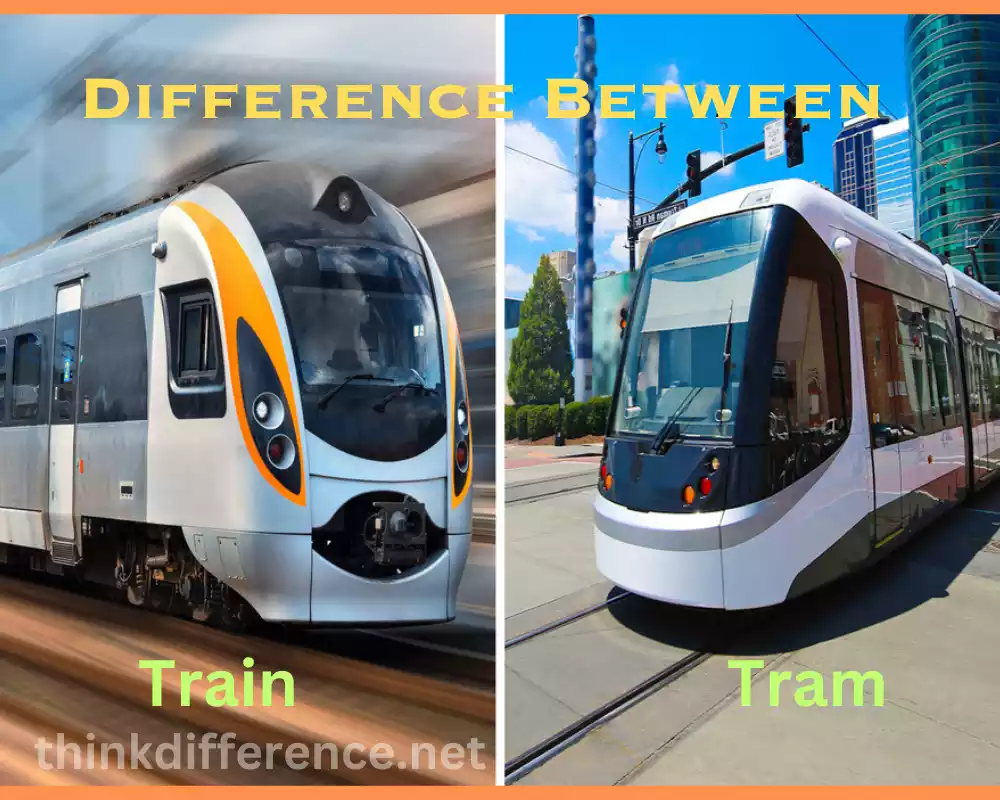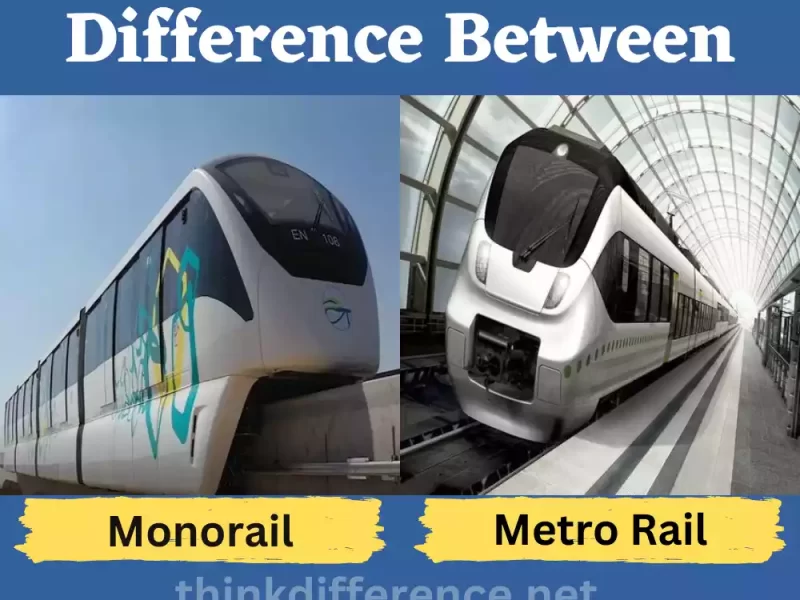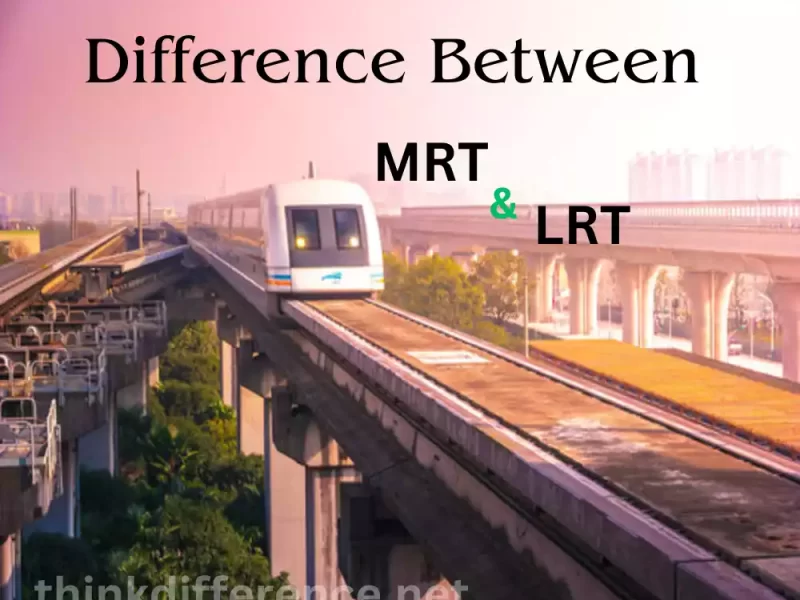Introduction to Train and Tram
Trams and trains are two common forms of intercity travel that play an essential part. Although their similarities overlap significantly, each mode offers distinct characteristics that distinguish it. Commuters and transport planners need to fully comprehend these distinctions between trams and trains in order to plan travel accordingly.
Definition of Train: Trains are organized systems of vehicles that run along tracks. Used mainly for long distance travel, commuter transport between cities, freight transport and passenger conveyance, they typically feature large, spacious vehicles capable of accommodating numerous passengers or cargo at one time. Running on dedicated railway networks they often reach high speeds which makes them the perfect way to cover long distances quickly and comfortably.
Definition of Tram: Trams often referred to simply as trams are light rail transport that operates in urban environments and cities. Similar to trains but typically more cost effective for shorter journeys within metropolitan areas or cities. Trams typically run along tracks embedded into streets or lines embedded into tramway routes and their primary purpose is local passenger transportation with frequent stops providing easy access to various destinations within towns or cities.
The Evolution of Trains and Trams
Trains and trams have transformed dramatically throughout history. Technological advances, infrastructure improvements and changes to design all contributed to shaping these modes of transport from its humble horse-drawn beginnings all the way up to today’s electric-powered vehicles. This section investigates major milestones of trains/trams/other public transportation throughout their evolution/development/change over time.
Early Origins and Steam-Powered Trains
Early Trams
- Horse-Drawn Trams: One of the first forms of urban transportation was horse-drawn trolleys introduced during the early 19th Century. Operating along tracks, these trams offered more efficient service compared to horse-drawn wagons.
Steam-Powered Trains
- James Watt was responsible for inventing the steam engine during the 18th century, opening up opportunities for steam-powered trains.
- George Stephenson and Stockton and Darlington Railway In 1825, George Stephenson’s locomotive “Locomotion No.” became part of Stockton and Darlington Railway’s inaugural public passenger train hauled by its steam power. This locomotive later served as its original home.
- Railway networks continue to expand globally. Steam locomotives became incredibly popular during the 19th century, leading to an explosion of railway networks on every continent.
Electric Trams and Early Electric Trains
Electric Trams:
- Electric trams were first introduced during the late 19th Century. These trams could either use overhead wires or underground conduit systems as sources of power.
- Electric trams offer several distinct advantages over their steam counterparts: They’re quieter, smoother rides and move much quicker.
Early Electric Trains:
- Thomas Edison and Werner von Siemens created electric locomotives during the late 19th century.
- Early electric train systems. Electric trains were first introduced as an alternative to steam-powered trains for urban transit purposes in Berlin, London and New York in 1896.
Technological Advancements and Modernization
Diesel and Electric Trains:
- Diesel trains are the future: By the middle of the 20th century, diesel locomotives had begun replacing steam trains due to their greater efficiency and reduced maintenance requirements.
- Electrification: Many intercity and urban railway networks have become electrified to allow faster and more eco-friendly electric trains on these networks.
Modern Tram Systems:
- Light rail systems: Light rail transit (LRTs) was pioneered during the middle 20th century as an amalgamation of tram flexibility with traditional railroad characteristics.
- Trams have made technological strides: Modern trams offer more comfort, accessibility, and efficiency thanks to advanced propulsion systems and other features that enhance comfort, access and efficiency.
Characteristics of Trains
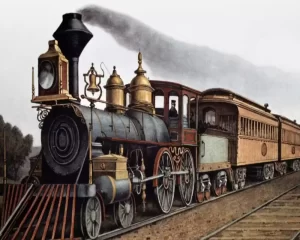
Trains offer an efficient and versatile form of transport due to their many unique characteristics, serving both passenger and freight transportation needs. Trains possess key attributes including:
- Purpose and Functions of Trains: Trains have been created with one purpose in mind – efficiently moving cargo or passengers over long distances, connecting various towns, cities and industrial centres along their routes. Trains offer an efficient alternative to driving cars.
- Size and Capacity: Trains offer higher capacity than any other mode of transport, consisting of several connected wagons or carriages with various purposes and numbers depending on type and purpose. Their design makes the train capable of accommodating large passenger numbers as well as freight loads.
- Tracks and Infrastructure: Train tracks are designed specifically to offer stability and guidance during their passage across various terrain. A railway infrastructure typically comprises switches, signaling system, stations and tracks arranged strategically so as to allow safe travel over various surfaces and terrain types.
- Power Source: Dependent upon the type and technology of a train, different energy sources may power it. Traditional steam locomotives used wood or coal as their energy source to generate steam to propel themselves; modern trains generally rely on electricity; this source may come from overhead wires, third rail systems or batteries or fuel cell systems installed aboard their trains.
- Speed and Travel distance: Trains have earned themselves an esteemed reputation for rapidly covering long distances, their speeds depending on type and infrastructure – high-speed trains can reach up to 300 km/h in some instances!
- Types of Trains: Different trains exist for specific uses and each serves their intended function well. Trains come in an assortment of types.
- Trains designed specifically to transport commuters: These trains connect residential areas with city centers, transport passengers between urban or suburban locations and offer fast yet comfortable travel between major cities.
- High-speed trains: High-speed trains offer rapid yet comfortable travel between major cities.
- Freight trains: Freight trains serve industries and logistic operations by transporting materials over long distances.
- Tourist trains: Tourist trains cater specifically towards tourism by offering scenic routes, unforgettable experiences and other services that attract passengers.
Trains play an indispensable part of our transportation system, offering safe and eco-friendly means for freight and passenger travel alike. Their versatility also contributes to economic development in regions across the world and the globalization process.
Characteristics of Trams
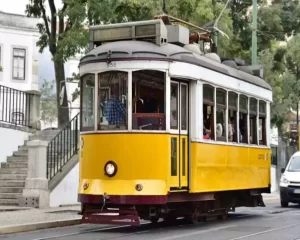
A tram or streetcar is an iconic form of urban transport with special characteristics that makes them highly appealing to city residents. Trams offer convenient and cost-efficient travel within cities while connecting neighborhoods through public transit systems – among many other uses! Here are some key characteristics associated with trams:
- Purpose and Function: Trams serve an indispensable function in urban transportation systems reliable and easily accessible passenger transport that offers an attractive alternative to private cars for moving passengers through densely-populated cities and reduce traffic in densely populated regions.
- Size and Capacity: Trams are smaller in comparison with trains, making them much easier to maneuver through narrow streets and corridors. Comprised of connected carriages that accommodate an adequate number of passengers – though their capacity depends upon design considerations; both standing and sitting options may be available – trams offer flexibility as transportation solutions in urban environments.
- Tram Tracks and Infrastructure: Teatrul trams travel on tracks either embedded in the street or along dedicated tram lines. Trams follow these tracks to travel reliably within cities; their infrastructure also features stations, stops, overhead power wires and signal systems for optimal operation.
- Power Source: Trams operate using electricity; overhead wires transmit it. Electric motors on board use that electricity to propel forward movement; this makes trams more environmentally-friendly as opposed to using fossil fuels as power source.
- Speed and Travel Distance: Trams typically operate at lower speeds than trains; typically around 20-50 km/h (12-31.3 mph). They’re designed for efficient urban transport that makes frequent stops within communities; in this sense they make their mark across shorter distances to connect neighborhoods with urban centres.
- Types of Trams: Transport systems such as trams come in many varieties to accommodate individual preferences and meet unique requirements.
- Streetcars: Streetcars are trams which operate within urban environments and share roads with cars, typically featuring vintage aesthetics or heritage aesthetics to maintain historic charm within cities.
- Light Rail Transit (LRT): LRT systems use modern trams operating on tracks with dedicated access or on sections sharing road access; their characteristics combine aspects of both tram and train travel and offer increased capacity and faster speed compared to streetcars.
- Heritage Trams: Heritage trams, restored or preserved vintage models used as tourist attractions or special events to showcase the history of tram systems are an attractive tourist attraction and showcase that history.
Trams form an integral component of urban public transport systems, offering reliable and cost-efficient means of moving around cities. Their size, power supply and dedicated tracks make trams particularly suitable to this form of travel.
Differences between Trains and Trams
Understanding the differences between trams and trains is vital to selecting and appreciating them as modes of urban and intercity transportation.
Here are a few key differences:
1. Infrastructure and Tracks:
- Trains: Trains run along tracks separate from roads. These tracks have been constructed specifically to handle high speeds, heavy loads and long distance travel; many trains serve multiple cities or regions across a region.
- Trams: Trams typically operate along embedded tracks in streets or dedicated tram lines in urban infrastructure; sometimes shared with other vehicles and covering shorter distances in metropolitan or city environments than most vehicles do.
2. Purpose and Function:
- Trains: Trains are built specifically for long distance travel and the transportation of large groups or goods across various regions and cities. Trains provide an effective method of traveling intercity or internationally quickly between major cities allowing rapid transit over vast distances.
- Trams: Trams are an accessible local transport option in urban environments that serve to facilitate movement throughout cities and neighborhoods. As part of larger public transit systems, trams operate locally while offering convenient public transport solutions at larger scale.
3. Size and Capacity:
- Trains: Trains are generally larger and can carry both passengers and freight efficiently. Multiple connected wagons or carriages make transporting large loads possible as well as accommodating numerous passengers.
- Trams: Trams differ in that they’re generally composed of one or two connected tramcars with reduced passenger capacities compared to trains; yet can still provide ample local transportation solutions for many individuals.
4. Power Source:
- Trains: Trains can be powered by diesel fuel, electric power or steam (historically). Electric trains use overhead lines and third rails while diesel trains typically rely on internal combustion engines.
- Trams: Trams rely on electricity as their primary power source, drawing power from overhead lines or underground conduit systems. Modern trams may use onboard energy storage devices like battery systems to improve efficiency and decrease dependence on overhead wires.
5. Speed and Travel Distance:
- Trains: Trains have the capacity to move at high speeds on railway tracks that have been specifically designated for this use, providing for long distance travel between cities or regions across vast distances.
- Trams: Trams operate at a slower speed than trains and are designed for frequent stops over shorter distances within urban areas, providing convenient transport across them. Trams also serve local communities by serving them and their transportation needs within city limits.
Understanding the differences between trams and trains can help you choose the optimal mode of transport based on your travel requirements, distance and purpose. Trams tend to excel at local urban transportation while trains excel in intercity travel over longer distances – both modes being integral components in providing efficient yet comprehensive solutions that meet various needs simultaneously.
Similarities between Trains and Trams
Trains and trams share some similarities that demonstrate their purpose as public transportation options to support urban mobility. Below are a few comparisons between trams and trains:
- Public Transportation: Trains and trams both provide public transportation services that facilitate movement within cities as well as between regions.
- Rail-Based Systems: Trams and trains utilize rail-based systems for their operations, with tracks providing predictable and stable routes for these modes of transport compared with buses or cars. Rail infrastructure distinguishes it as distinct form other modes such as buses or cars.
- Fixed Routes: Trams and trains typically follow well-established fixed routes that take into account factors like population density, demand for transportation services and connectivity with important destinations.
- Dedicated Stops and Stations: Trains and trams both feature stops and stations along their routes for passengers to use as points for boarding or disembarking, creating efficient passenger transfer processes. Many stations feature amenities like platforms, shelters or ticketing facilities for an optimal passenger experience.
- Integration With Public Transit Networks: Trains and trams can easily integrate into larger public transit networks in cities. When linked together with buses or metros, trains and trams ensure smooth journeys while increasing accessibility for users.
- Mass Transport: Trams and trains offer efficient mass transit solutions that enable larger groups to move more effectively while simultaneously decreasing individual vehicle usage.
- Environmental Benefits of Trains and Trams: Trains and trams both help the environment by decreasing emissions of carbon dioxide while supporting sustainability goals. Many consider them greener alternatives than private vehicles when it comes to relieving urban congestion, helping lessen traffic delays as a result.
- Safety Measures: Trains and trams place great importance on safety measures to safeguard passengers. Railway industry members adhere to industry regulations and standards when designing railway transportation; emergency brakes, signal systems and protocols for boarding/debarking are implemented as safety features to meet them.
Trains and trams each possess distinct attributes, yet their role as public transportation systems that depend on rails illustrate their commonalities. By understanding them as integral pieces in urban mobility and overall transportation infrastructure we can better appreciate their contributions.
Examples of Train Systems
Numerous railway systems connect cities, regions and countries globally. Each train system features unique technology, speed and purpose – these train systems serve as notable examples from around the world.
- Shinkansen (literally “Bullet Train”): Japan’s high speed rail network has earned itself the name “Bullet Train”. Debuted as the world’s inaugural high-speed railway system in 1964, Shinkansen trains can travel up to 200 mph (321 km/h). They connect major Japanese cities including Tokyo, Osaka and Kyoto.
- TGV (France): The Train a Grande Vitesse, more commonly referred to as TGV, is France’s high speed rail network known for its sleek look and rapid travel time. Connecting French cities as well as international destinations like London Geneva and Brussels (among many others), TGV holds the record as world’s fastest train service reaching speeds over 574 km/hr (357 mph). Test runs of TGV reached over this mark during trial runs!
- Deutsche Bahn (Germany): Deutsche Bahn operates an extensive rail network across Germany and offers various intercity, regional and high-speed train services including Intercity-Express for travel between major cities like Berlin, Frankfurt and Munich.
- Amtrak in United States: Amtrak operates as the nation’s passenger railroad system and connects major cities throughout America through an expansive train network. Amtrak offers regional trains, long distance services and Acela Express high speed services along the Northeast Corridor corridor.
- Eurostar (Europe): Eurostar provides an international high-speed rail service connecting Britain to mainland Europe through the Channel Tunnel, linking London with Paris, Brussels and other European cities – offering passengers a convenient and comfortable travel option between these locations.
- Indian Railways: Spanning across India’s vast territory is one of the world’s largest rail networks – linking remote rural regions with major urban centres while offering both passenger and cargo service. There are different kinds of trains running within this network such as local commuter and long-distance services as well as luxury tourist trains such as
Maharajas’ Express or Palace on Wheels for sightseeing tourism purposes. - Trans-Siberian Railway: This iconic route connects Moscow with the Far East via railway spanning over 9,000 km (5,600 mi). Travel along this unforgettable landscapes and cultures journey.
These examples represent just some of the many train systems worldwide that exist and function efficiently to transport goods and passengers across various regions and nations. Each is uniquely distinguished in features, services and technologies they employ; all contribute towards efficiently moving people and goods between regions or nations.
Examples of Tram Systems
Around the globe, tram systems provide convenient and sustainable urban transport systems. Below are several notable tram networks around the globe:
- Melbourne Tram Network: Australia’s Melbourne Tram Network is amongst one of the world’s largest. Covering more than 250 km (155 miles), Melbourne Trams serve various suburbs and cities throughout Australia with both low-floor modern trams as well as heritage trams in their fleet.
- Muni Metro (San Francisco, United States): Muni Metro operates in San Francisco, California. Consisting of both underground and above-ground sections – with underground sections serving downtown San Francisco – Muni Metro offers convenient transport throughout San Francisco connecting neighborhoods as well as key destinations like Fisherman’s Wharf or Union Square.
- Docklands Light Railway of London: The Docklands Light Railway (DLR) is an automated light rail system used primarily to connect London’s Docklands district to other parts of its capital city. Offering convenient transportation for commuters as well as visitors of London’s financial district with driverless trains and elevated sections.
- Tram 28 (Lisbon, Portugal): Tram 28 of Lisbon (Portugal) has quickly become one of the city’s premier tourist attractions. Tram 28 is an historic tramline which traverses narrow streets through which major landmarks and picturesque neighborhoods pass, giving guests a memorable way to see all that Lisbon has to offer – such as Alfama, Graca and Baixa – without even needing a car!
- Strasbourg Tramway (France): The Strasbourg Tramway operates in France’s city of Strasbourg and boasts an extensive tram network which fits seamlessly into city planning – what has made this system particularly renowned is the low-floor trams which prioritize sustainability as part of this system and contributes towards maintaining Strasbourg as an environmental model city through efficient transit services.
- Hong Kong Tramways: Since 1904, the Hong Kong Tramways have provided Hong Kongers a cheap and nostalgic form of transport across northern Hong Kong Island. Covering both commercial and residential districts alike. Double-decker trams serve a number of commercial enterprises and residential communities on this bustling city island.
- Randstad Rail connects: The Hague and Rotterdam in the Netherlands via traditional tram lines combined with converted rail tracks for commuter travel and travel between both cities. It provides commuter services between these cities.
These examples display the diversity of tram systems globally. Their role can be seen as efficient urban transport, preservation of heritage sites and contribution towards sustainable mobility within cities.
Safety Measures in Trains and Trams
Trains and trams both prioritize passenger and staff safety to protect both people travelling onboard as well as staff working there, with various safety measures implemented in both to minimize accident risks, ensure continued operational excellence and create an atmosphere free of risk. Below are examples of safety features common across trams and trains:
- Emergency Braking System: Trams and trains are equipped with emergency brake systems designed to quickly stop them in an emergency, either manually by their drivers, or automatically via software programs, helping reduce severity or avoid collisions altogether. These emergency systems help decrease severity or avoid collisions altogether.
- Signal and Communication Systems: Trains and tram networks employ advanced signaling systems for traffic regulation and safe distance maintenance, while communication devices like intercoms and two-way radios allow drivers to quickly communicate with control centers or passengers during emergencies or operational needs.
- CCTV Surveillance: Cameras installed inside trains and trams provide closed circuit television (CCTV) surveillance to improve security by monitoring activities inside. CCTV also helps detect threats or suspicious behaviors and can serve as evidence in case an incident takes place.
- Fire Safety: Trams and trains are equipped with systems of detection and suppression to minimize fire risks, such as smoke detectors, emergency ventilation systems and fire extinguishers to control smoke inhalation and reduce spreading.
- Passenger Safety Information: Trains and trams provide safety instructions and information to their passengers within their vehicles, including emergency procedures, evacuation routes and general guidelines that serve to improve overall passenger wellbeing. Signs, posters and audio announcements serve to inform riders about emergency procedures, evacuation routes and general precautionary guidelines that apply when travelling aboard these modes of transit.
- Platform Safety: Train and tram stations have safety measures installed at them to provide passengers with protection on the platforms, including platform edge barriers and tactile pavering that serve to avoid accidents on them. Clear signage indicates safe areas.
- Accessibility Features: Trains, trams and buses often include features to accommodate passengers with disabilities or limited mobility such as priority boarding, designated seating arrangements, ramps and accessible toilets.
- Maintenance and Inspection: Trains and trams receive routine maintenance inspections to identify any safety issues and address them effectively. Brakes, doors and signaling systems are checked regularly in order to reduce risk associated with equipment failure resulting in accidents.
- Staff Training: Train and tram operators receive intensive staff training in safety protocols, emergency protocols and passenger assistance procedures. In particular, operators learn to handle emergency situations calmly while managing crowds effectively to provide prompt assistance to passengers when needed.
These safety measures aim to create a pleasant and safe travel environment on trams and trains while increasing efficiency while mitigating potential risks. Our transportation network remains safe through regular inspections and constant surveillance.
Case Studies of Successful Train and Tram Systems
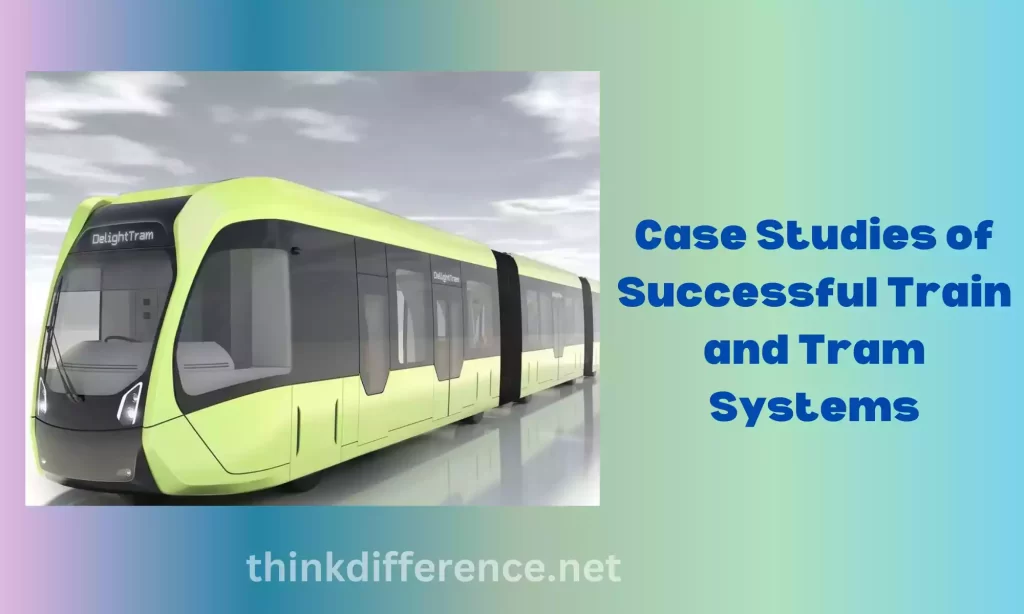
Train
- High-Speed Rail in Japan (Shinkansen): Shinkansen (Bullet Train) is Japan’s highly successful high-speed rail system. Since 1964 it has completely revolutionized Japan’s transportation industry and been key in connecting major cities like Tokyo, Osaka and Kyoto – significantly decreasing travel times, airport congestion and road congestion while providing reduced travel times and congestion at airports and roads. To stay at the top as an industry leader it continues to introduce innovative technology including maglev trains as well as additional safety features to maintain its world leading status.
- Eurostar (Europe): Eurostar, the high-speed train system connecting mainland Europe and Britain via rail travel, is an acclaimed high-speed railway system which has revolutionized travel between major European cities such as London, Paris and Brussels. Eurostar trains reach speeds up to 300km/h (186mph), providing for an enjoyable trip compared to air travel; its reliability, comfort, sustainability credentials are often lauded compared to air travel services; additionally this high speed system has allowed tourists easier access to popular tourist spots across Europe while creating economic and cultural links across borders as a result.
Tram
- Zurich Tram Network (Switzerland): Zurich Tram Network is widely recognized for its reliability and efficiency. This extensive tram system connects neighborhoods, business districts and cultural attractions using modern low-floor trams that ensure accessibility for all passengers. Notable aspects of Zurich Tram Network’s service delivery include punctuality, frequency of services provided as well as its integration with other transportation modes – hallmarks which have significantly decreased car use, reduced congestion levels in Zurich traffic jams and fostered sustainable urban mobility in Zurich.
- Melbourne Tram Network (Australia): Melbourne Tram Network has become an essential element of Melbourne’s transportation infrastructure over time. Spanning over an extensive area in Melbourne and renowned for its reliability, frequency and wide reach – residents and tourists can use its convenient tram service for convenient transport in Melbourne. Furthermore, trams contribute greatly to Melbourne’s vibrant livable atmosphere by decreasing traffic volume while increasing sustainable transportation initiatives, increasing access to neighborhoods, attractions and services within its boundaries and improving accessibility between different neighborhoods or attractions.
These case studies highlight the success of tram and train systems around the globe, including how these modes have significantly contributed to urban mobility, sustainability, connectivity and connectivity issues. Success of tram/train systems stems from factors like efficient operations, investments in infrastructure upgrades/improvements as well as continuous improvements focusing on passenger satisfaction/safety measures.
Conclusion
Trains and Trams have come a long way since their humble beginnings, shaping the world’s cities and connecting people like never before. With ongoing advancements in technology and a growing focus on sustainability, these transportation modes are well-positioned to continue evolving, meeting the challenges of the future and remaining vital components of modern urban life.

